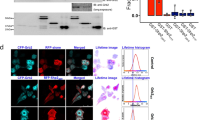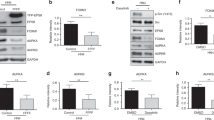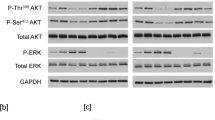Abstract
Here, we report the identification and characterization of a novel tyrosine phosphorylation site in the carboxy-terminal Src Homology 3 (SH3) (SH3C) domain of the Crk adaptor protein. Y251 is located in the highly conserved RT loop structure of the SH3C, a region of Crk involved in the allosteric regulation of the Abl kinase. Exploiting kinase assays to show that Y251 is phosphorylated by Abl in vitro, we generated affinity-purified antisera against phosphorylated Y251 in Crk and showed that Abl induces phosphorylation at Y251 in vivo, and that the kinetics of phosphorylation at Y251 and the negative regulatory Y221 site in vitro are similar. Y251 on endogenous Crk was robustly phosphorylated in chronic myelogenous leukemia cell lines and in A431 and MDA-MB-468 cells stimulated with epidermal growth factor. Using streptavidin–biotin pull downs and unbiased high-throughput Src Homology 2 (SH2) profiling approaches, we found that a pY251 phosphopeptide binds specifically to a subset of SH2 domains, including Abl and Arg SH2, and that binding of pY251 to Abl SH2 induces transactivation of Abl 1b. Finally, the Y251F Crk mutant significantly abrogates Abl transactivation in vitro and in vivo. These studies point to a yet unrealized positive regulatory role resulting from tyrosine phosphorylation of Crk, and identify a novel mechanism by which an adaptor protein activates a non-receptor tyrosine kinase by SH2 domain displacement.
This is a preview of subscription content, access via your institution
Access options
Subscribe to this journal
Receive 50 print issues and online access
$259.00 per year
only $5.18 per issue
Buy this article
- Purchase on Springer Link
- Instant access to full article PDF
Prices may be subject to local taxes which are calculated during checkout






Similar content being viewed by others
References
Abassi YA, Vuori K . (2002). Tyrosine 221 in Crk regulates adhesion-dependent membrane localization of Crk and Rac and activation of Rac signaling. EMBO J 21: 4571–4582.
Anafi M, Rosen MK, Gish GD, Kay LE, Pawson T . (1996). A potential SH3 domain-binding site in the Crk SH2 domain. J Biol Chem 271: 21365–21374.
Birge RB, Fajardo JE, Reichman C, Shoelson SE, Songyang Z, Cantley LC et al. (1993). Identification and characterization of a high-affinity interaction between v-Crk and tyrosine-phosphorylated paxillin in CT10-transformed fibroblasts. Mol Cell Biol 13: 4648–4656.
Birge RB, Kalodimos C, Inagaki F, Tanaka S . (2009). Crk and CrkL adaptor proteins: networks for physiological and pathological signaling. Cell Commun Signal 7: 13.
Dubielecka PM, Machida K, Xiong X, Hossain S, Ogiue-Ikeda M, Carrera AC et al. (2010). Abi1/Hssh3bp1 pY213 links Abl kinase signaling to p85 regulatory subunit of PI-3 kinase in regulation of macropinocytosis in LNCaP cells. FEBS Lett 584: 3279–3286.
Escalante M, Courtney J, Chin WG, Teng KK, Kim JI, Fajardo JE et al. (2000). Phosphorylation of c-Crk II on the negative regulatory Tyr222 mediates nerve growth factor-induced cell spreading and morphogenesis. J Biol Chem 275: 24787–24797.
Fathers KE, Rodrigues S, Zuo D, Murthy IV, Hallett M, Cardiff R et al. (2010). CrkII transgene induces atypical mammary gland development and tumorigenesis. Am J Pathol 176: 446–460.
Feller SM . (2001). Crk family adaptors-signalling complex formation and biological roles. Oncogene 20: 6348–6371.
Feller SM, Knudsen B, Hanafusa H . (1994). c-Abl kinase regulates the protein binding activity of c-Crk. EMBO J 13: 2341–2351.
Gotoh T, Hattori S, Nakamura S, Kitayama H, Noda M, Takai Y et al. (1995). Identification of Rap1 as a target for the Crk SH3 domain-binding guanine nucleotide-releasing factor C3G. Mol Cell Biol 15: 6746–6753.
Guris DL, Fantes J, Tara D, Druker BJ, Imamoto A . (2001). Mice lacking the homologue of the human 22q11 2 gene CRKL phenocopy neurocristopathies of DiGeorge syndrome. Nat Genet 27: 293–298.
Hantschel O, Nagar B, Guettler S, Kretzschmar J, Dorey K, Kuriyan J et al. (2003). A myristoyl/phosphotyrosine switch regulates c-Abl. Cell 112: 845–857.
Hashimoto Y, Katayama H, Kiyokawa E, Ota S, Kurata T, Gotoh N et al. (1998). Phosphorylation of CrkII adaptor protein at tyrosine 221 by epidermal growth factor receptor. J Biol Chem 273: 17186–17191.
Johnson KJ, Griswold IJ, O'Hare T, Corbin AS, Loriaux M, Deininger MW et al. (2009). A BCR-ABL mutant lacking direct binding sites for the GRB2, CBL and CRKL adapter proteins fails to induce leukemia in mice. PLoS One 4: e7439.
Jones RB, Gordus A, Krall JA, MacBeath G . (2006). A quantitative protein interaction network for the ErbB receptors using protein microarrays. Nature 439: 168–174.
Kiyokawa E, Hashimoto Y, Kurata T, Sugimura H, Matsuda M . (1998). Evidence that DOCK180 up-regulates signals from the CrkII-p130(Cas) complex. J Biol Chem 273: 24479–24484.
Klemke RL, Leng J, Molander R, Brooks PC, Vuori K, Cheresh DA . (1998). CAS/Crk coupling serves as a “molecular switch” for induction of cell migration. J Cell Biol 140: 961–972.
Knudsen BS, Feller SM, Hanafusa H . (1994). Four proline-rich sequences of the guanine-nucleotide exchange factor C3G bind with unique specificity to the first Src homology 3 domain of Crk. J Biol Chem 269: 32781–32787.
Kobashigawa Y, Sakai M, Naito M, Yokochi M, Kumeta H, Makino Y et al. (2007). Structural basis for the transforming activity of human cancer-related signaling adaptor protein CRK. Nat Struct Mol Biol 14: 503–510.
Linghu H, Tsuda M, Makino Y, Sakai M, Watanabe T, Ichihara S et al. (2006). Involvement of adaptor protein Crk in malignant feature of human ovarian cancer cell line MCAS. Oncogene 25: 3547–3556.
Machida K, Thompson CM, Dierck K, Jablonowski K, Karkkainen S, Liu B et al. (2007). High-throughput phosphotyrosine profiling using SH2 domains. Mol Cell 26: 899–915.
Matsuda M, Hashimoto Y, Muroya K, Hasegawa H, Kurata T, Tanaka S et al. (1994). CRK protein binds to two guanine nucleotide-releasing proteins for the Ras family and modulates nerve growth factor-induced activation of Ras in PC12 cells. Mol Cell Biol 14: 5495–5500.
Matsuda M, Mayer BJ, Fukui Y, Hanafusa H . (1990). Binding of transforming protein, P47gag-crk, to a broad range of phosphotyrosine-containing proteins. Science 248: 1537–1539.
Matsuda M, Tanaka S, Nagata S, Kojima A, Kurata T, Shibuya M . (1992). Two species of human CRK cDNA encode proteins with distinct biological activities. Mol Cell Biol 12: 3482–3489.
Matsumoto T, Yokote K, Take A, Takemoto M, Asaumi S, Hashimoto Y et al. (2000). Differential interaction of CrkII adaptor protein with platelet-derived growth factor alpha- and beta-receptors is determined by its internal tyrosine phosphorylation. Biochem Biophys Res Commun 270: 28–33.
Mayer BJ, Hamaguchi M, Hanafusa H . (1988). A novel viral oncogene with structural similarity to phospholipase C. Nature 332: 272–275.
Miller CT, Chen G, Gharib TG, Wang H, Thomas DG, Misek DE et al. (2003). Increased C-CRK proto-oncogene expression is associated with an aggressive phenotype in lung adenocarcinomas. Oncogene 22: 7950–7957.
Muralidharan V, Dutta K, Cho J, Vila-Perello M, Raleigh DP, Cowburn D et al. (2006). Solution structure and folding characteristics of the C-terminal SH3 domain of c-Crk-II. Biochemistry 45: 8874–8884.
Nagashima K, Endo A, Ogita H, Kawana A, Yamagishi A, Kitabatake A et al. (2002). Adaptor protein Crk is required for ephrin-B1-induced membrane ruffling and focal complex assembly of human aortic endothelial cells. Mol Biol Cell 13: 4231–4242.
Nishihara H, Tanaka S, Tsuda M, Oikawa S, Maeda M, Shimizu M et al. (2002). Molecular and immunohistochemical analysis of signaling adaptor protein Crk in human cancers. Cancer Lett 180: 55–61.
Noren NK, Foos G, Hauser CA, Pasquale EB . (2006). The EphB4 receptor suppresses breast cancer cell tumorigenicity through an Abl-Crk pathway. Nat Cell Biol 8: 815–825.
Park TJ, Boyd K, Curran T . (2006). Cardiovascular and craniofacial defects in Crk-null mice. Mol Cell Biol 26: 6272–6282.
Plattner R, Kadlec L, DeMali KA, Kazlauskas A, Pendergast AM . (1999). c-Abl is activated by growth factors and Src family kinases and has a role in the cellular response to PDGF. Genes Dev 13: 2400–2411.
Reichman C, Singh K, Liu Y, Singh S, Li H, Fajardo JE et al. (2005). Transactivation of Abl by the Crk II adapter protein requires a PNAY sequence in the Crk C-terminal SH3 domain. Oncogene 24: 8187–8199.
Reichman CT, Mayer BJ, Keshav S, Hanafusa H . (1992). The product of the cellular crk gene consists primarily of SH2 and SH3 regions. Cell Growth Differ 3: 451–460.
Ren R, Ye ZS, Baltimore D . (1994). Abl protein-tyrosine kinase selects the Crk adapter as a substrate using SH3-binding sites. Genes Dev 8: 783–795.
Ribon V, Saltiel AR . (1996). Nerve growth factor stimulates the tyrosine phosphorylation of endogenous Crk-II and augments its association with p130Cas in PC-12 cells. J Biol Chem 271: 7375–7380.
Rodrigues SP, Fathers KE, Chan G, Zuo D, Halwani F, Meterissian S et al. (2005). CrkI and CrkII function as key signaling integrators for migration and invasion of cancer cells. Mol Cancer Res 3: 183–194.
Rosen MK, Yamazaki T, Gish GD, Kay CM, Pawson T, Kay LE . (1995). Direct demonstration of an intramolecular SH2-phosphotyrosine interaction in the Crk protein. Nature 374: 477–479.
Sarkar P, Reichman C, Saleh T, Birge RB, Kalodimos CG . (2007). Proline cis-trans isomerization controls autoinhibition of a signaling protein. Mol Cell 25: 413–426.
Sarkar P, Saleh T, Tzeng SR, Birge RB, Kalodimos CG . (2011). Structural basis for regulation of the Crk signaling protein by a proline switch. Nat Chem Biol 7: 51–57.
Shishido T, Akagi T, Chalmers A, Maeda M, Terada T, Georgescu MM et al. (2001). Crk family adaptor proteins trans-activate c-Abl kinase. Genes Cells 6: 431–440.
Songyang Z, Shoelson SE, Chaudhuri M, Gish G, Pawson T, Haser WG et al. (1993). SH2 domains recognize specific phosphopeptide sequences. Cell 72: 767–778.
Sorokin A, Reed E, Nnkemere N, Dulin NO, Schlessinger J . (1998). Crk protein binds to PDGF receptor and insulin receptor substrate-1 with different modulating effects on PDGF- and insulin-dependent signaling pathways. Oncogene 16: 2425–2434.
Srinivasan D, Plattner R . (2006). Activation of Abl tyrosine kinases promotes invasion of aggressive breast cancer cells. Cancer Res 66: 5648–5655.
Srinivasan D, Sims JT, Plattner R . (2008). Aggressive breast cancer cells are dependent on activated Abl kinases for proliferation, anchorage-independent growth and survival. Oncogene 27: 1095–1105.
Tanaka S, Morishita T, Hashimoto Y, Hattori S, Nakamura S, Shibuya M et al. (1994). C3G, a guanine nucleotide-releasing protein expressed ubiquitously, binds to the Src homology 3 domains of CRK and GRB2/ASH proteins. Proc Natl Acad Sci USA 91: 3443–3447.
Tanis KQ, Veach D, Duewel HS, Bornmann WG, Koleske AJ . (2003). Two distinct phosphorylation pathways have additive effects on Abl family kinase activation. Mol Cell Biol 23: 3884–3896.
Wang L, Tabu K, Kimura T, Tsuda M, Linghu H, Tanino M et al. (2007). Signaling adaptor protein Crk is indispensable for malignant feature of glioblastoma cell line KMG4. Biochem Biophys Res Commun 362: 976–981.
Xiong X, Cui P, Hossain S, Xu R, Warner B, Guo X et al. (2008). Allosteric inhibition of the nonMyristoylated c-Abl tyrosine kinase by phosphopeptides derived from Abi1/Hssh3bp1. Biochim Biophys Acta 1783: 737–747.
Zvara A, Fajardo JE, Escalante M, Cotton G, Muir T, Kirsch KH et al. (2001). Activation of the focal adhesion kinase signaling pathway by structural alterations in the carboxyl-terminal region of c-Crk II. Oncogene 20: 951–961.
Acknowledgements
This work was in part supported by the NIH grant RO1GM080308 to CK and RBB, as well as NJCCR pre-doctoral fellowship 08-1093-CCR-EO to AT. We thank Leszek Kotula, Eric Haura and Khanh Nguyen for helpful discussion, and Neil Devoe for critical comments on the MS.
Author information
Authors and Affiliations
Corresponding author
Ethics declarations
Competing interests
The authors declare no conflicts of interest.
Additional information
Supplementary Information accompanies the paper on the Oncogene website
Rights and permissions
About this article
Cite this article
Sriram, G., Reichman, C., Tunceroglu, A. et al. Phosphorylation of Crk on tyrosine 251 in the RT loop of the SH3C domain promotes Abl kinase transactivation. Oncogene 30, 4645–4655 (2011). https://doi.org/10.1038/onc.2011.170
Received:
Revised:
Accepted:
Published:
Issue Date:
DOI: https://doi.org/10.1038/onc.2011.170
Keywords
This article is cited by
-
Cyclophilin A promotes cell migration via the Abl-Crk signaling pathway
Nature Chemical Biology (2016)
-
The adaptor protein Crk in immune response
Immunology & Cell Biology (2014)
-
SH3 domains: modules of protein–protein interactions
Biophysical Reviews (2013)
-
Domain organization differences explain Bcr-Abl's preference for CrkL over CrkII
Nature Chemical Biology (2012)



